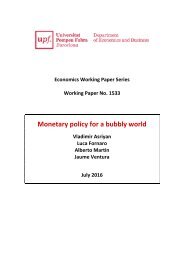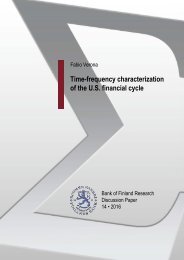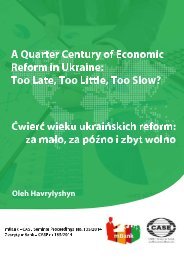Necessity as the mother of invention monetary policy after the crisis
n?u=RePEc:dnb:dnbwpp:525&r=mac
n?u=RePEc:dnb:dnbwpp:525&r=mac
You also want an ePaper? Increase the reach of your titles
YUMPU automatically turns print PDFs into web optimized ePapers that Google loves.
mo<strong>the</strong>r <strong>of</strong> <strong>invention</strong>. Indeed, one <strong>of</strong> <strong>the</strong>se unconventional tools, forward guidance, relies<br />
entirely on communication. But more communication w<strong>as</strong> also required regarding o<strong>the</strong>r<br />
policies.<br />
The <strong>crisis</strong>, <strong>the</strong> deployment <strong>of</strong> unconventional <strong>monetary</strong> policies, and <strong>the</strong> broader<br />
(sometimes tacit) mandates made discussions surrounding <strong>the</strong> actions <strong>of</strong> <strong>monetary</strong> <strong>policy</strong><br />
committees more controversial than ever. And that, in turn, affected <strong>the</strong> way central banks<br />
communicated. The need for more and better communication w<strong>as</strong> exacerbated by <strong>the</strong><br />
incre<strong>as</strong>ingly public debate over such controversial are<strong>as</strong> <strong>as</strong> <strong>the</strong> possible distributional<br />
effects <strong>of</strong> UMP, or <strong>the</strong> role <strong>of</strong> <strong>the</strong> central bank in bailing out financial institutions—or, in<br />
<strong>the</strong> c<strong>as</strong>e <strong>of</strong> <strong>the</strong> euro area, entire governments. For all <strong>the</strong>se re<strong>as</strong>ons and o<strong>the</strong>rs, <strong>the</strong>re have<br />
been many changes in central bank communication practices since <strong>the</strong> <strong>crisis</strong>. To list only<br />
a few <strong>of</strong> <strong>the</strong> most important ones:<br />
Both <strong>the</strong> Federal Reserve and <strong>the</strong> Bank <strong>of</strong> Japan introduced a formal inflation<br />
objective in early 2012. Historically, inflation objectives had been introduced<br />
following periods <strong>of</strong> high and volatile inflation in an attempt to stabilize inflation<br />
at lower levels and to anchor inflation expectations. In contr<strong>as</strong>t, <strong>the</strong> inflation<br />
objectives in <strong>the</strong> United States and Japan were introduced following periods <strong>of</strong><br />
low inflation (Ehrmann, 2015).<br />
The Fed h<strong>as</strong> expanded its communication toolkit in various o<strong>the</strong>r ways: Since<br />
April 2011, <strong>the</strong> FOMC chair holds regular press conferences, and since 2012, <strong>the</strong><br />
Summary <strong>of</strong> Economic Projections contains a forec<strong>as</strong>t for <strong>the</strong> Fed’s <strong>policy</strong> rate,<br />
in <strong>the</strong> form <strong>of</strong> a “dot plot” that collects <strong>the</strong> judgements <strong>of</strong> <strong>the</strong> individual FOMC<br />
members <strong>of</strong> <strong>the</strong> appropriate level <strong>of</strong> <strong>the</strong> <strong>policy</strong> rate over three calendar years and<br />
<strong>the</strong> longer run.<br />
The Bank <strong>of</strong> England now rele<strong>as</strong>es <strong>the</strong> minutes <strong>of</strong> its <strong>policy</strong> meetings and <strong>the</strong><br />
Inflation Reports at <strong>the</strong> same time <strong>as</strong> its <strong>policy</strong> decisions.<br />
A number <strong>of</strong> central banks have aired substantially more internal disagreement<br />
since <strong>the</strong> <strong>crisis</strong>. The most prominent such example may be <strong>the</strong> ECB, which saw<br />
its earlier principle <strong>of</strong> one-voice communication seriously challenged in light <strong>of</strong><br />
<strong>the</strong> considerable disagreement among its Governing Council members, and<br />
started rele<strong>as</strong>ing regular accounts <strong>of</strong> <strong>monetary</strong> <strong>policy</strong> discussions <strong>as</strong> <strong>of</strong> January<br />
2015.<br />
All <strong>of</strong> <strong>the</strong>se changes go in <strong>the</strong> same direction—towards more transparency—a trend<br />
which is in line with <strong>the</strong> evolution we had already observed in our 2008 article and with<br />
<strong>the</strong> survey results summarized in Table 9 above.<br />
Having seen such pr<strong>of</strong>ound changes in <strong>the</strong> practice <strong>of</strong> central bank communication, it<br />
seems natural to <strong>as</strong>k to what extent <strong>the</strong>se changes are here to stay. Or will <strong>the</strong>y be scaled<br />
back once normalcy is restored? Our take is that many <strong>of</strong> <strong>the</strong> more structural changes are<br />
here to stay. It will be close to impossible, and most likely also undesirable, to stop holding<br />
press conferences or publishing minutes. In a similar vein, we would not expect <strong>the</strong><br />
Federal Reserve or <strong>the</strong> Bank <strong>of</strong> Japan to abolish <strong>the</strong>ir inflation objectives, though <strong>the</strong>ir<br />
levels might possibly be adjusted (see Section 2).<br />
25








